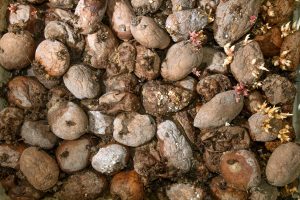Welcome to our exploration of composting with oak leaves! In our journey through the world of composting, we often come across a variety of organic materials, each with its own unique benefits and challenges. Oak leaves, although rich in nutrients, carry an acidic quality and a waxy coating that can sometimes make us wonder if they’re fit for our compost bins. Together, we’ll uncover the ins and outs of composting these autumnal gifts, ensuring that we turn them into nourishing, sustainable soil for our gardens. Let’s dive into the art and science of composting oak leaves and discover how we can make the most of this abundant resource. Have you ever found yourself standing in the middle of your yard, surrounded by a thick layer of fallen oak leaves, and wondered, “Can I compost these oak leaves?” If you have, you’re not alone. Many of us who care about our gardens and the environment find ourselves asking this very question each autumn. The good news is that the answer is a resounding yes! We can compost oak leaves, and doing so can bring a plethora of benefits to our gardens and reduce waste going to the landfill.
Understanding Oak Leaves
Before diving into the composting process, it’s crucial to understand the characteristics of oak leaves. Oak leaves are often seen as a challenge in composting circles, but by grasping their unique properties, we can learn how to handle them effectively.
Characteristics of Oak Leaves
Oak leaves come from various species of oak trees and are known for their tough, leathery texture. They often have a high lignin content, which makes them more resistant to decomposition compared to other types of leaves.
| Leaf Type | Lignin Content | Decomposition Rate |
|---|---|---|
| Oak Leaves | High | Slow |
| Maple Leaves | Low | Fast |
| Birch Leaves | Medium | Moderate |
Acidity Concerns
We’ve all heard concerns about the acidity of oak leaves. Oak leaves are slightly acidic with a pH typically around 4.5 to 5. However, as they decompose, this acidity neutralizes, making them a suitable addition to our compost.
Nutrient Content
Oak leaves are rich in trace minerals. While they may not provide a significant amount of nitrogen, they do add valuable nutrients like potassium and calcium to our compost, which can enhance the overall health of our soil.
Benefits of Composting Oak Leaves
Composting oak leaves is not just a practical way to deal with yard waste; it also has significant environmental and horticultural benefits.
Reducing Landfill Waste
By composting oak leaves, we contribute to reducing landfill waste. Organic matter in landfills breaks down anaerobically, releasing methane, a potent greenhouse gas. Composting converts this waste into a valuable resource without harmful emissions.
Improving Soil Health
When added to the garden, composted oak leaves improve soil structure, enhance moisture retention, and increase beneficial microbial activity. This can lead to healthier plants and more robust garden yields.
Cost-Effective Solution
Composting at home can save us money. Instead of buying commercial soil amendments, we can use our homemade compost, which is both cost-effective and environmentally friendly.

The Composting Process
Now that we know the benefits, let’s delve into how we can effectively compost oak leaves. The process involves a few steps, but with a little patience and attention, we can turn those tough leaves into rich, black gold for our garden.
Shredding the Leaves
One of the first steps in composting oak leaves is to shred them. Shredding increases the surface area of the leaves, enhancing microbial activity and speeding up the decomposition process. We can use a lawnmower with a bag attachment or a leaf shredder for this task.
Balancing the Carbon-Nitrogen Ratio
Oak leaves are considered a ‘brown’ or carbon-rich material. To balance them, we need to mix them with ‘green’ or nitrogen-rich materials like kitchen scraps, grass clippings, or manure. A good starting ratio is 30 parts carbon to 1 part nitrogen.
| Material | Carbon to Nitrogen Ratio |
|---|---|
| Oak Leaves | 50:1 |
| Grass Clippings | 20:1 |
| Kitchen Scraps | 15:1 |
| Manure | 20:1 |
Layering the Compost Pile
Creating layers in our compost pile helps with aeration and ensures even decomposition. Start with a layer of coarse material like straw or small branches to aid air circulation. Then, alternate layers of shredded oak leaves (carbon) and green materials (nitrogen).
Maintaining Moisture Levels
Our compost pile should be as moist as a wrung-out sponge. If it’s too dry, decomposition slows down; if it’s too wet, it can become anaerobic and smell unpleasant. We may need to add water during dry periods or cover the pile to protect it from excessive rain.
Turning the Pile
Turning the compost pile regularly ensures that all parts of the pile are aerated and decomposing evenly. A good rule of thumb is to turn the pile every 1 to 2 weeks. This helps to speed up the composting process and prevents odors.
Troubleshooting Common Issues
Sometimes, even with the best efforts, our compost pile may experience issues. Here are some common problems and tips on how we can resolve them.
Slow Decomposition
If our oak leaves are decomposing slowly, it could be due to a lack of nitrogen or insufficient shredding. Adding more green materials and ensuring the leaves are well-shredded can help.
Foul Odors
A smelly compost pile usually indicates an anaerobic condition. This can be fixed by turning the pile more often to increase oxygen flow and adding dry materials to balance moisture levels.
Pest Infestation
If pests like rodents or insects are a problem, we might need to adjust our composting practices. Avoid adding meat, dairy, or oily foods, and consider using a compost bin with a lid to keep pests out.

Using Composted Oak Leaves
After a few months, our compost pile should start to resemble dark, crumbly soil with an earthy smell. This indicates that our oak leaves have successfully decomposed.
Mulching and Soil Amendment
We can use our composted oak leaves as mulch around plants. This helps retain moisture, suppress weeds, and slowly release nutrients. Alternatively, we can mix the compost directly into the soil to improve its structure and fertility.
Making Leaf Mold
Another fantastic use for oak leaves is to make leaf mold. Leaf mold is simply decomposed leaves that are high in organic matter and excellent for soil conditioning. To make leaf mold, just pile up shredded oak leaves in a wire bin or secluded area and let them decompose over time. This can take a year or two, but the result is a highly beneficial soil amendment.
Conclusion
So, can we compost oak leaves? Absolutely! With a little extra effort and understanding of their unique properties, oak leaves can become a valuable addition to our composting routine. By shredding, balancing with nitrogen-rich materials, maintaining moisture, and turning the pile regularly, we can turn those tough oak leaves into rich compost that benefits our gardens and the environment. Let’s embrace the fall season and turn our oak leaf problem into a composting opportunity!
Remember, patience and persistence are key. Happy composting!



